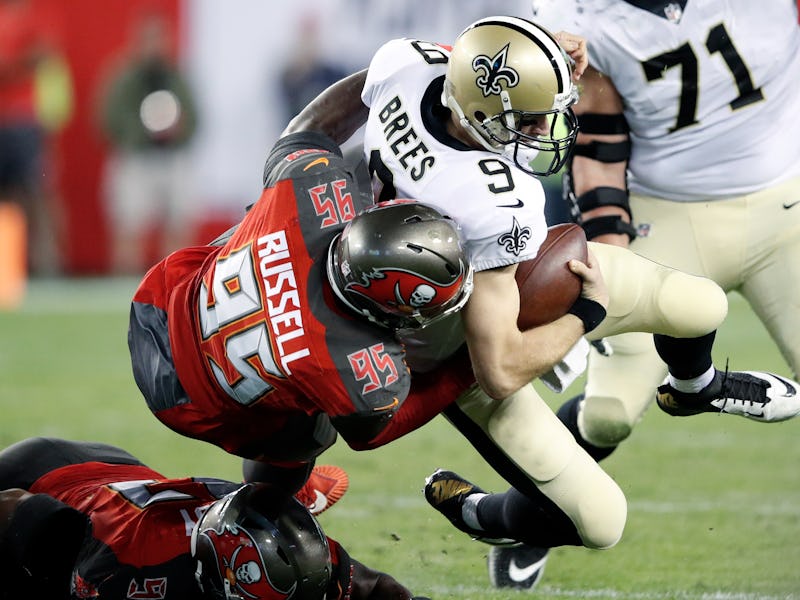Regenerating Fish Brains May Hold the Key to the NFL's Concussion Problem
Unlike human brains, these brains grow back.

Traumatic brain injuries in the NFL are routine and cause cognitive problems down the line, including chronic traumatic encephalopathy, a degenerative condition that can cause depression, aggression, and dementia. Medical researchers are working on solutions to lessen the long-term effects of traumatic brain injury on athletes and other people in high-risk professions like military service members, but these solutions are probably still a number of years away. To get a better handle on the issue, medical researchers are looking to an unexpected species for solutions.
One of the biggest issues with brain injuries in humans is that once the brain’s nerve cells die, they don’t usually regenerate. But that’s not true for all animals: In a paper published Tuesday in the journal eNeuro, a team of researchers at W.M. Keck Science Center showed that the zebrafish (Danio rerio) regenerates brain cells after mild traumatic brain injury — also known as a concussion — and explored their mechanisms for doing so, in hopes that they could find parallels in the human brain.
Unlike human brain cells, zebrafish neurons regenerate after traumatic brain injury.
In the study, the researchers examined how the fish behaved after a mild traumatic brain injury, and at the same time, they investigated which genes were active during the injury recovery period, in hopes of finding out which genes were correlated with neuron regrowth.
To give the fish concussions, scientists put the zebrafish into a device whose sole purpose is to give a fish a mild traumatic brain injury by dropping a ball bearing on its head. Fish are anesthetized for this procedure, but when they recover from the blow, they show a classic sign of concussion: difficulty navigating spatial problems. Zebrafish typically navigate in schools to avoid predators and improve their ability to gather food — a behavior they normally do quite naturally. Those that had gotten concussions, however, had difficulty remembering how to return to their shoaling peers. Humans and other animals exhibit spatial difficulties after traumatic brain injury, too.
Researchers used this machine to give mild traumatic brain injuries to anesthetized zebrafish. They dropped a 0.33-gram ball bearing right between each fish's eyes. Unlike humans, zebrafish can regenerate nerve cells after such an injury.
After three weeks, when the fish seemed to have mostly recovered from their injuries, the researchers killed the fish and sequenced their RNA to find out which genes were linked to the growth of new neurons. The data pointed to several genes — which previous groups had already characterized in terms of identity and function — but what makes this study different is that it shows a clear association between the gene expression patterns and recovery from traumatic brain injury. These results, the authors note, are similar to the results of similar studies performed on adult rodents.
It may seem strange, but the brains of zebrafish are actually pretty good scientific models for human brains.
It may sound strange for scientists to be studying fish brains as a way to understand human brains, but in fact, zebrafish and human brains share some surprising similarities. About 70 percent of human genes have at least one gene that performs the same or similar function in a zebrafish, the authors note, and in this study, the genetic line of zebrafish the researchers used has a genome that’s particularly similar to that of humans.
This study might not have yielded any particularly actionable results yet, but the more we know about how brains can recover from traumatic brain injury, the closer we get to being able to help humans who have suffered brain damage. Perhaps gene therapies could help us mimic certain elements of neuroregeneration that zebrafish display. And even though the NFL has been notoriously behind the times when it comes to accepting scientific evidence, they have begun to take an active role in encouraging research on brain injuries.
Abstract: Mild traumatic brain injuries (mTBIs) are one of the most prevalent neurological disorders; yet, humans are severely limited in their ability to repair and regenerate central nervous system (CNS) tissue post injury. However, zebrafish (*Danio rerio) maintain the remarkable ability to undergo complete and functional neuroregeneration as an adult. We wish to extend knowledge of the known mechanisms of neuroregeneration by analyzing the differentially expressed genes (DEGs) in a novel adult zebrafish model of mTBI. In this study, a rodent weight drop model of mTBI was adapted to the adult zebrafish. A memory test showed significant deficits in spatial memory in the mTBI group. We then identified DEGs at 3 and 21 days post injury (dpi) through RNA-sequencing analysis. The resulting DEGs were categorized according to gene ontology (GO) categories. At 3 dpi GO categories consisted of peak injury response pathways. Significantly, at 21 dpi, GO categories consisted of neuroregeneration pathways. Ultimately, these results validate a novel zebrafish model of mTBI and elucidate significant DEGs of interest in CNS injury and neuroregeneration.